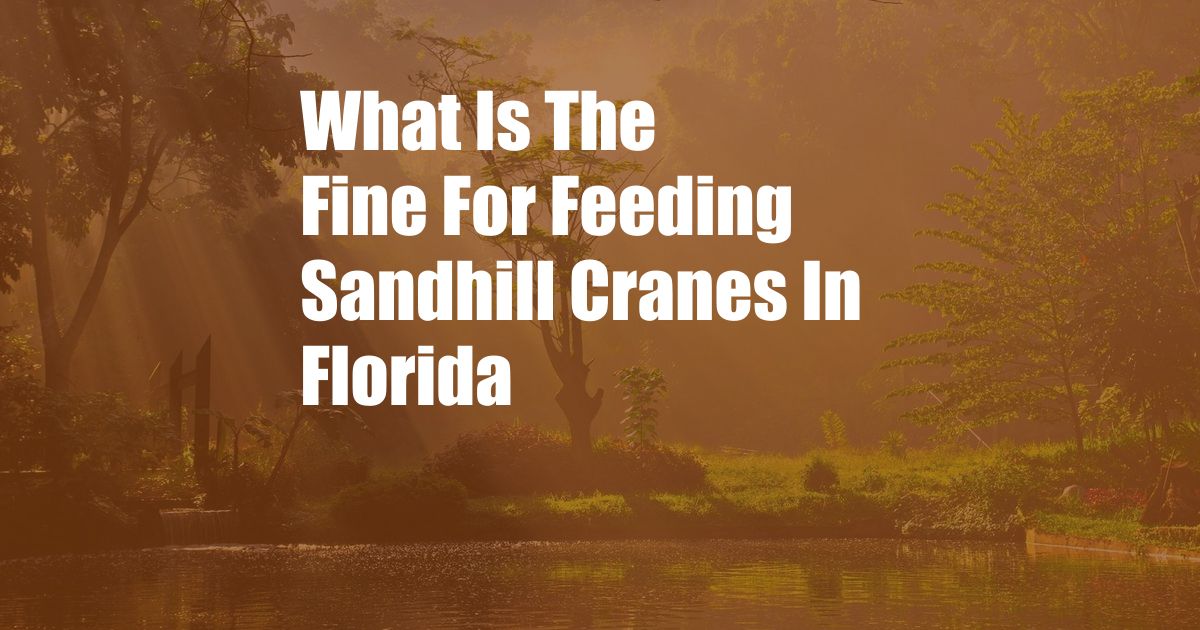
What’s the Penalty for Feeding Sandhill Cranes in Florida?
In the vast, sun-kissed landscapes of Florida, sandhill cranes, with their distinctive red crowns and graceful strides, are a common sight. While it may be tempting to offer these magnificent birds a handout, doing so is strictly prohibited by state law and can result in severe consequences. This comprehensive guide will delve into the reasons behind this prohibition and provide valuable insights into the importance of protecting these remarkable creatures.
Known for their gregarious nature, sandhill cranes often gather in large groups, especially during the winter months. While their amiable demeanor may entice people to approach and feed them, it is crucial to remember that these birds are wild animals and should not be habituated to human interaction.
Unnatural Feeding Habits
When sandhill cranes are fed by humans, they develop an unnatural dependence on people for sustenance. This can disrupt their natural feeding behaviors and make them more vulnerable to predators. Cranes that rely on human handouts may neglect their instinctual foraging skills and become unable to find food on their own.
Aggression and Habituation
Feeding sandhill cranes can lead to aggression, particularly during the nesting season. When these birds perceive humans as a source of food, they may approach people aggressively in search of handouts. This behavior can be intimidating and even dangerous, especially for children or the elderly.
Furthermore, feeding sandhill cranes habituates them to human presence, increasing the risk of vehicle collisions and other accidents. Cranes that are accustomed to humans may lose their natural fear of people and wander into populated areas, exposing themselves to potential hazards.
Disease Transmission
Sharing food with sandhill cranes can facilitate the transmission of diseases between humans and birds. Feeding these birds from your hands or offering them human food can introduce bacteria and viruses into their population, potentially leading to illness or even death.
In addition to the health risks posed to sandhill cranes, human food is often not nutritionally appropriate for these birds. Cranes that consume processed or sugary foods may experience digestive problems and other health issues.
Legal Consequences
Feeding sandhill cranes in Florida is not only unethical but also illegal. The Florida Fish and Wildlife Conservation Commission (FWC) enforces strict penalties for violating this regulation.
According to FWC regulations, it is unlawful to feed any wildlife species that is not specifically designated as a game animal. Sandhill cranes are classified as a non-game species, meaning that they are protected by state law. Individuals who are caught feeding these birds face fines of up to $500 and potential jail time.
Tips and Expert Advice
To protect sandhill cranes and avoid legal consequences, it is crucial to refrain from feeding these birds. Instead, observe them from a distance and appreciate their natural beauty. If you encounter a sandhill crane, keep your distance and do not approach it. Remember that these birds are wild animals and should be treated with respect.
Educate others about the importance of not feeding sandhill cranes. By spreading awareness, we can help protect these magnificent birds and ensure their well-being for generations to come.
FAQ
-
Q: Why is it illegal to feed sandhill cranes in Florida?
A: Feeding sandhill cranes in Florida is prohibited because it disrupts their natural feeding behaviors, makes them vulnerable to predators, and can habituate them to human presence, leading to aggression and other problems.
-
Q: What are the penalties for feeding sandhill cranes in Florida?
A: Individuals who are caught feeding sandhill cranes in Florida face fines of up to $500 and potential jail time.
-
Q: What should you do if you encounter a sandhill crane?
A: If you encounter a sandhill crane, keep your distance and do not approach it. Observe the bird from a respectful distance and appreciate its natural beauty.
Conclusion
Sandhill cranes are an integral part of Florida’s diverse ecosystem, and it is our responsibility to protect these remarkable birds. By understanding the reasons behind the prohibition against feeding sandhill cranes and adhering to the regulations set forth by the FWC, we can ensure the well-being of these majestic creatures for future generations. Remember, observing sandhill cranes from a distance is the best way to appreciate them and protect their natural heritage.
Are you interested in learning more about sandhill cranes and other Florida wildlife? Explore additional resources to deepen your knowledge and understanding of these fascinating creatures.